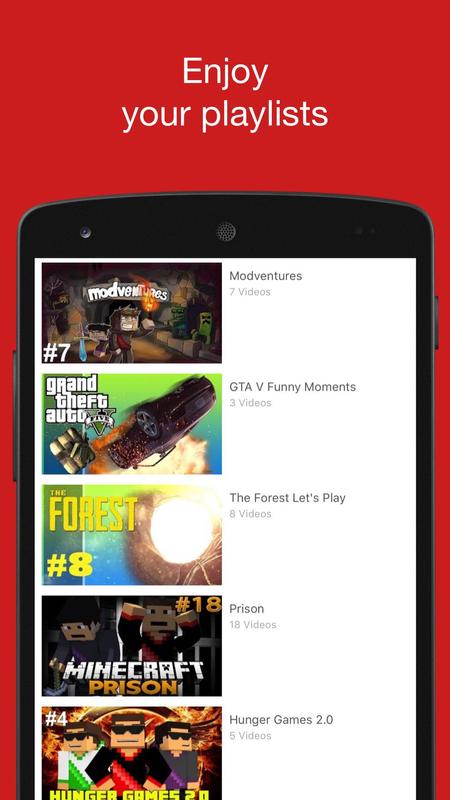Vido Android Youtube Multi Channel
- Vido Android Youtube Multi Channel System
- Vido Android Youtube Multi Channel Youtube
- Vido Android Youtube Multi Channel Online
More posts by this contributor.Remember MCNs? Those quaint multi-channel networks — aggregators of channels — that generally focused on a specific vertical audience? (kids), (gamers), (fashion/beauty), (food/travel), (sports), (Latino), (dance/music) — just to name a few.

With Streamaxia OpenSDK, any brand can embed live video streaming services into its app, allowing its user communities to broadcast content to any popular live streaming service – like Facebook Live, YouTube Live, Microsoft Azure or its own branded network – simultaneously from one branded app. We call these multi-channel simulcasting apps.

And don’t forget the broader-based mega-aggregators like and.MCNs — that acronym and aggregation “plays” — were all the rage 2-3 years ago. Several of them got snapped up back then in “the YouTube economy.” started it all when it was acquired by DreamWorks Animation three years ago for about $120 million (and just recently valued at $650 million when Verizon acquired a 24.5 percent share last month only to find Comcast three weeks later buying all of it as part of its own $3.8 billion DreamWorks mega-deal).Then, one year later, Disney — in a media shot heard ’round the world — bought Maker Studios for a deal ultimately worth $600-$700 million.
Vido Android Youtube Multi Channel System
Next up, Fullscreen (Otter Media paid between $200-$300 million) and StyleHaul (Bertelsmann/RTL’s ultimate price tag is between $150-$200 million).Ah, those were the days!But in the past year or so, something curious happened. All of these companies shied away from the “MCN” moniker.
Some did so violently, contending they were never MCNs in the first place. And, where have all the acquirers gone?
Below are the five reasons this happened.The MCN business model didn’t workInitially, MCNs were all about scale. After scale was achieved, it was time to monetize; most MCNs focused first on ad revenues. But sheer mass served merely with ads never effectively monetized (especially since MCNs shared ad revenues with YouTube, which was overflowing with inventory) and pure aggregation “plays” became suspect.MCN-represented creators became discouragedA challenged ad-driven business model meant that the video creators’ shares of those challenged revenues frequently didn’t meet expectations. On top of that, creators who were not amongst the top performers increasingly felt they were not getting the attention they deserved.Original and branded content took center stageAwesomenessTV saw the writing early on, built its own internal slate of creators and developed and distributed its own original, exclusive content. It honed its production craft and built a compelling library of stories and characters that it could exploit and monetize over and over again — including on both traditional platforms (like TV) and new platforms (OTT). It isn’t a YouTube-only world anymore.Add brand-funded content (which it did) and you had a powerful one-two punch that knocked down the former ad-only model.
The result? Scale and profitability — and Verizon’s recent massive investment and Comcast’s even more massive acquisition. Other MCNs eventually adopted AwesomenessTV’s model. They have, in essence, become digital-first production companies, and AwesomenessTV is their aspirational poster child.Building a meaningful brand matteredFrom the beginning, AwesomenessTV proudly trumpeted its brand to the world. Yes, it developed, distributed and marketed multiple characters and titles. But the AwesomenessTV brand stood tall above all else and, importantly to the audience, stood for something — premium, safe kids’ content. Many other “artists formerly known as MCNs” (an homage to Prince from a fellow Minnesotan) didn’t “get” this umbrella branding strategy until much later on.Several initially marketed their top individual creators first — and their brand second. This led to confusion.
What exactly did the MCN stand for? That mattered to consumers, which meant that it mattered to advertisers, distributors and investors.The term “MCN” doesn’t fit the new video ecosystem“Multi-channel network” referred to companies that literally aggregated multiple YouTube (and only YouTube) channels together in a YouTube subset and under a different name.
Vido Android Youtube Multi Channel Youtube
But, guess what? It isn’t a YouTube-only world anymore. Now, of course, we have Facebook, Snapchat, Twitter, Amazon and a host of other behemoths that have significantly evolved into digital-first media companies themselves.These “off YouTube” platforms are increasingly important to both creators and the former MCNs supporting them that want to distribute their content across as many platforms as possible (tailored to the specific DNA of each).That’s why “MCNs” are simply a relic of the past. Those that are content-category leaders today are simply new media companies — focused on producing compelling digital-first content that can be significantly monetized across multiple platforms.

Vido Android Youtube Multi Channel Online
AwesomenessTV shows them (and their investors) the way to the promised land of M&A.